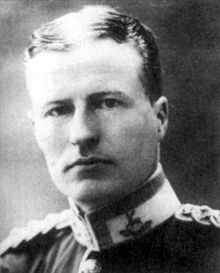Ellis Ashmead-Bartlett
| Ellis Ashmead-Bartlett | |
|---|---|

Ellis Ashmead-Bartlett
|
|
| Born | 11 February 1881 |
| Died | 4 May 1931 (aged 50) Lisbon, Portugal |
| Occupation | war correspondent |
| Years active | 1902–1920 |
Ellis Ashmead-Bartlett (11 February 1881 – 4 May 1931) was an English war correspondent during the First World War. Through his reporting of the Battle of Gallipoli, Ashmead-Bartlett was instrumental in the birth of the Anzac legend which still dominates military history in Australia and New Zealand. Through his outspoken criticism of the conduct of the campaign, he was instrumental in bringing about the dismissal of the British commander-in-chief, Sir Ian Hamilton – an event that led to the evacuation of British forces from the Gallipoli peninsula.
Born in 1881, Ashmead-Bartlett was the eldest son of Conservative Party MP, Sir Ellis Ashmead-Bartlett. He went to Marlborough College and served as a lieutenant in The Bedfordshire Regiment during the Boer War. In April 1902 he was called to the bar at Inner Temple. Two years later, Ashmead-Bartlett arrived in Manchuria to report the Russo-Japanese War. Soon after the war, he published one of the major books on that conflict: Port Arthur: The Siege and Capitulation (William Blackwood & Sons).
Ashmead-Bartlett's role as a war correspondent reached maturity during World War I. As correspondent for the Fleet Street papers, Ashmead-Bartlett, who worked for The Daily Telegraph, covered 25 April 1915 landing at Anzac Cove. He had gone ashore at Anzac Cove at 9.30 p.m. on the evening of the landing and, wearing a non-regulation green hat, was promptly arrested as a spy but was released when the boatswain who had brought him ashore testified for him.
...
Wikipedia
